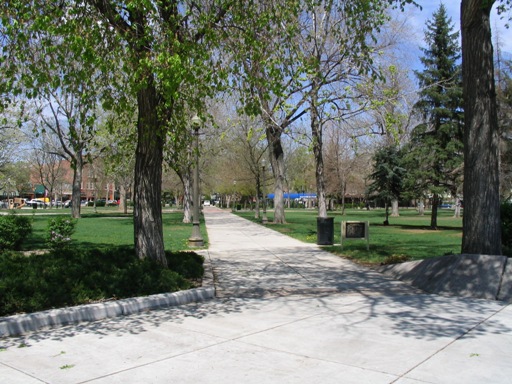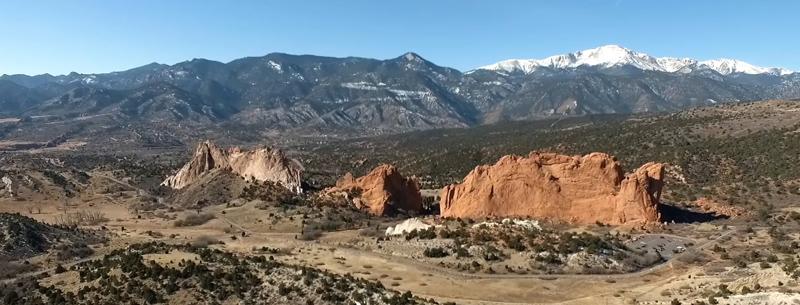Colorado Springs Parks & Recreation gives you a way to play.
This town was built upon its outdoor reputation. The sparkling outdoors was all that kept this city going when there was nothing here and no reason to come.
You can check here if you are trying to reserve a park facility or here to find a sport to play in Colorado Springs.
Colorado Springs Parks
Parks we’ve profiled:
- Garden of the Gods
- Palmer Park
- Bear Creek Park
- North Cheyenne Canon
- Pulpit Rock Open Space
- Paint Mines Park
- Monument Valley Park
- Memorial Park
- America the Beautiful Park
- Laura Gilpin Park
Park History
When Colorado Springs filed the original town plat in 1871, it included one city block as the first city-owned park in the Colorado Springs parks and recreation. The park, known as North Park or Acacia Square is the site of the present-day Acacia Park.
Colorado Springs’ city founder General William Jackson Palmer generously donated 1,270 acres of parkland, bridle and footpaths, scenic drives and roadways planted with trees, to establish a significant foundation of the Colorado Springs parks and recreation system. These gifts included Acacia (North) Park, Monument Valley Park, Antlers Park, Pioneer Square (South) Park, Palmer Park, Prospect Lake, and Bear Creek Canon.
In 1879, Charles Perkins, president of the Chicago Burlington & Quincy Railroad, purchased much of the land now known as the Garden of the Gods. After his death, at his request, his family gave the land to the City of Colorado Springs to be used as a park. The stipulations included that it be known as Garden of the Gods and it would remain free forever to all visitors. In 1909, the Perkins heirs gave Garden of the Gods Park to the city, adding to the beautiful parklands already established.
Discover the Colorado Springs Parks and Recreation System
And the number of parks in Colorado Springs continues to grow. There are over 8000 acres of parks in Colorado Springs. Almost every school and neighborhood has an associated park. This was done by design. The outdoors are such an important part of Colorado Springs, that they are included in most new subdivision designs. There are three types of parks in Colorado Springs.

Neighborhood Parks are generally one to six acres in size and are intended to be within walking distance of the neighborhood in which they serve. Amenities can include walking paths, playgrounds, picnic tables, small picnic pavilions, sod grass areas, backstops and/or dirt infields, basketball courts, tennis courts, or in-line hockey facilities.
Community Parks are generally 25 to 100 acres in size and are intended to serve the needs of several neighborhoods as well as community-wide needs. Community parks provide active recreational facilities such as athletic fields, swimming pools, community recreation buildings, and/or other special features that cannot be readily accommodated in neighborhood parks. Other amenities can include walking paths, open sod grass areas, picnic areas with pavilions, playgrounds as well as court facilities found in neighborhood parks.
Regional Parks are typically over 100 acres in size and include a major natural area or regional landmark. Parking areas, restrooms, trail access, and picnic areas are found in all the developed regional parks. Large portions of regional parks are retained in their natural states.
In addition to fun to be had at all the parks, there are many other activities to be found in the Colorado Springs area.
- Organized sports from Colorado Springs Parks and Recreation
- Hiking – many of the parks have great hiking trails
- Bike Riding – Palmer Park, Bear Creek Park, and Garden of the Gods and North Cheyenne Canon are great places to start
- Rock Climbing – Garden of the Gods and Red Rocks Canyon
According to Men’s Fitness Magazine magazine, Colorado Springs was the 3rd Fittest city in the United States in 2005.
Men’s Fitness notes that “Colorado Springs residents are more likely to play sports than their rivals in other cities surveyed, plus they are less at risk for health problems related to being overweight than the national average, according to the CDC. The high number of city parks, gyms and fitness studios in the city make Colorado Springs an ideal place for residents who desire a healthy lifestyle.” (emphasis added)
In 2009, Colorado Springs jumped a spot to number 2 on the list. In the 2009 issue, Men’s Fitness noted, “Colorado Springs’s park acreage per capita is 137 percent higher than average and the 3rd highest in our survey. Research has found a connection between access to parks and green space and reduced obesity rates.”
Here is a list of just a few of the parks in the Colorado Springs area.
- Garden of the Gods
- Palmer Park
- Bear Creek Park
- North Cheyenne Canon
- Pulpit Rock Open Space
- Paint Mines Park
- Monument Valley Park
- Memorial Park
- America the Beautiful Park
- Laura Gilpin Park
Done at the park? Leave Colorado Springs Parks and Recreation to Discover more of Colorado Springs!
